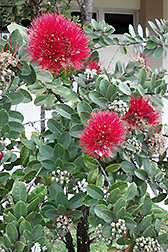| Read the magazine story to find out more. |
|
|
|
|
USDA Scientists and Partners Investigate Hawaiian Tree Deaths
February 27, 2017
A team of U.S. Department of Agriculture (USDA) scientists and their collaborators are pursuing a fungal killer that's attacking Hawaii's native 'Ōhi'a trees. Fortunately, their efforts are already turning up important new leads and tools to counter the fungus, known scientifically as Ceratocystis fimbriata.
Identified in 2014, C. fimbriata causes a vascular wilt disease called "Rapid 'Ōhi'a Death" (ROD) that's killed hundreds of thousands of 'Ōhi'a trees in forest and residential areas. Affected areas include the Big Island of Hawaii's South Hilo, Puna and Ka'ū districts, according to Lisa Keith, a plant pathologist with USDA's Agricultural Research Service (ARS) in Hilo, Hawaii.
She is part of a rapid-response research team that includes experts from the University of Hawaii, USDA Forest Service, U.S. Geological Survey, and Hawaii's departments of agriculture and land and natural resources.
Losing the 'Ōhi'a poses a significant threat to Hawaii because of the critical ecological role the tree plays in the state's native forests. This includes helping maintain watershed health and groundwater quality as well as providing habitat for rare and endangered species of plants, animals and insects. The tree also figures prominently in native Hawaiian culture.
The team's research includes:
- Evidence that at least two C. fimbriata species cause ROD.
- Genetic studies to determine what made the fungus so lethal to the 'Ōhi'a tree and when.
- Development and use of molecular techniques to rapidly detect the ROD-causing species and distinguish them from other types of the fungus—aiding efforts to accurately monitor the disease's spread, distribution and severity.
- Investigation of the role of wood-boring ambrosia beetles in the spread of the fungus' spores—and as targets for chemical control.
The team's efforts are already helping state officials, residents, property owners and others take action to safeguard Hawaii's remaining 'Ōhi'a tree population and preserve their ecological importance.
Read more about the ROD research in the February 2017 issue of AgResearch.
For more information contact Jan Suszkiw, ARS Office of Communications.
The Agricultural Research Service is the U.S. Department of Agriculture's chief scientific in-house research agency. Daily, ARS focuses on solutions to agricultural problems affecting America. Each dollar invested in agricultural research results in $17 of economic impact.


